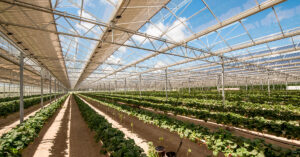GS 3 – AGRICULTURE

Context:
World Solar Day on 3rd May highlighted India’s efforts to promote agrivoltaics, aiming to harness solar energy while boosting agricultural productivity.
Agrivoltaics (APV)
Agrivoltaics refers to the co-location of solar photovoltaic panels and crops on the same land, enabling dual land use for both clean energy generation and agriculture. This approach maximizes land-use efficiency by integrating food and energy production, providing farmers with dual income streams. Solar panels are elevated to ensure adequate sunlight for crops while simultaneously generating solar power.
The concept was first introduced in 1981 by German scientists Adolf Goetzberger and Armin Zastrow.
India’s Solar Energy Growth
India’s solar capacity has grown dramatically from 2.82 GW in 2014 to 100.33 GW in 2025, marking a 3450% increase over a decade. In 2024, India added 24.5 GW of solar capacity, more than doubling its 2023 figures. Utility-scale solar installations grew by 2.8 times in 2024, reaching 18.5 GW, creating a strong foundation for the expansion of agrivoltaics.
Benefits of APVs
- Land-Use Efficiency: Simultaneous food and energy production on the same land maximizes land use.
- Improved Crop Resilience: Solar panels reduce heat stress and water evaporation, enhancing crop resilience.
- Additional Income for Farmers: Farmers can earn stable income by leasing land or selling excess solar power to the grid at a fixed feed-in tariff.
- Support for Shade-Tolerant Crops: Crops like tomatoes, potatoes, and turmeric thrive under the shade of solar panels.
- Risk Reduction: APVs help mitigate vulnerability to climate change and provide diverse income sources for small and marginal farmers.
Successful Case Studies
- Najafgarh (Delhi): A farmer earns ₹1 lakh per acre from solar leasing, and up to ₹1.5 lakh per acre by cultivating shade-tolerant crops.
- Sahyadri FPO (Maharashtra): A 250-kW agrivoltaic project growing grapes and citrus demonstrates the commercial viability of high-value crops.




